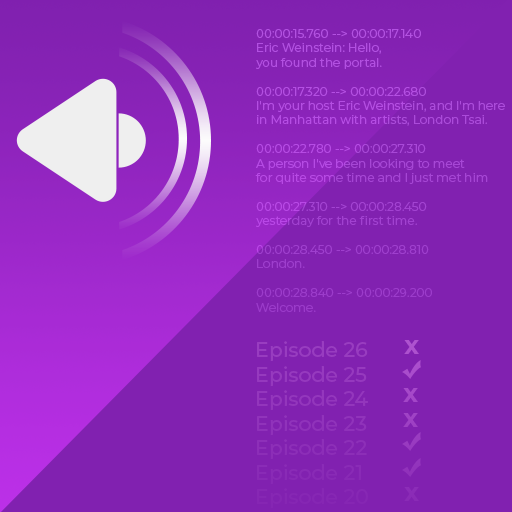Transcript Style Guide
This is the style guide for The Portal Transcripts.
| The Portal Transcripts (Transcript Completion Project) | |

| |
| Information | |
|---|---|
| Topic | The Portal Podcast |
| Leader | pyrope#5830 BeefSandwich27#0143 Aardvark#5610 |
| Start Date | 31 January 2020 |
| Methodology | Transcript Workflow |
| Style Guide | Wiki Page |
| Portal Media Spreadsheet | Sheet |
| Google Drive | Drive |
| Links | |
| Website | The Portal Blog |
| Discord | Link |
| The Portal Group Discord | Link |
| All Projects | |
General GuidelinesEdit
Our transcripts are in American English.
We use a clean verbatim style. This means filler words (um, uh, etc.), false starts, and repeated words or phrases, when they do not add meaning or nuance, are removed.
Headings are added to identify the discussion topic.
Word Processor ConfigurationEdit
Disable smart quotes in Preferences (see image on right).
Disable automatic substitutions in Preferences (see image on right).
Spelling HelpEdit
Search for unknown terms or names, or search for the words in their context to find their proper spelling. Google, Wikipedia, and arXiv should cover almost all cases.
HeadingsEdit
Generally, our transcripts will be posted on pages under a level 2 heading, so any subheadings in the transcript should begin at a level 3 heading.
ParagraphsEdit
Paragraphs should in general contain a whole idea.
Paragraphs are not indented.
An empty paragraph is left between paragraphs.
Paragraph BreaksEdit
Paragraph breaks don't always have to be for total change of topic. The next subtopic in a line of thought can be broken into its own paragraph to help readability. Also keep in mind that an increase of paragraphs will cause an increase of timestamps, which may be useful for more technical subjects.
TimestampEdit
The timestamp is italicized, always of the form HH:MM:SS (hours:minutes:seconds). It marks the beginning of a paragraph. It is separated by a line break (Shift + Enter) instead of a paragraph break from the paragraph proper. This can be checked by triple-clicking a paragraph to select it and seeing whether the timestamp is also highlighted as part of the selection.
Speaker TagEdit
The speaker tag is bold, punctuated by a colon, and in-line with the paragraph.
Only the first of consecutive paragraphs by a speaker should have a speaker tag.
Paragraphs immediately following a heading should have a speaker tag.
PunctuationEdit
CommasEdit
Use the Oxford comma.
Place a comma before single and double quotes that begin a new clause.
Certain repeated words should have commas in between them: "No, no, ..." and, "No, no, no, no, ..." for instance.
HyphenationEdit
Hyphenate certain words.
DashesEdit
Em-dash or long dash (—) for interruptions (mid-word or mid-sentence) or abrupt change in a sentence's topic. There is no space after the dash with the exception of starting a new sentence.
En-dash (–) multiple names used as an adjective, such as in Teller–Ulam design or Yang–Mills theory.
EllipsesEdit
Ellipses can be used in some places instead of dashes, if a speaker is trailing off for instance. Put a space after ellipses. They can be treated as periods or commas for the capitalization of the next word.
QuotationsEdit
Place a comma before single and double quotes that begin a new clause.
Use double quotes for dialogue or speech, terms or phrases, song titles, and scare quotes. For dialogue and speech, end-punctuation is placed inside the quote. Otherwise it is placed outside or the quote is left unpunctuated.
Use single quotes for thoughts. If the sentence ends inside of a single quote, end punctuation is placed inside the quote.
Indirect QuotationsEdit
Indirect quotes (no quote marks) are used for hypothetical speech or heavy paraphrasing. Use your own judgment. Place no comma before indirect quotes. Do not capitalize the first word of indirect quotes.
Spelling and Formatting Inside QuotationsEdit
If a speaker is directly reading or reciting a written work, it should be spelled and formatted exactly as it was originally written.
CapitalizationEdit
Capitalize essay titles.
Capitalize book titles.
Capitalize song titles.
AcronymsEdit
Acronyms are capitalized and unpunctuated: PhD, UK, USA, DISC, etc.
Slogans that reduce to acronyms are capitalized, i.e. "Make America Think Harder (MATH)".
Name acronyms are capitalized and punctuated: M.C. Escher.
Portal TermsEdit
Portal terms aren't capitalized: embedded growth obligation, gated institutional narrative, etc.
However, Portal terms that are explicitly proper nouns are capitalized: The Portal Podcast, Wokistan, Magastan
ItalicizationEdit
Italicize book titles.
Italicize foreign language phrases/terms i.e. sine qua non, unless they're in non-dialogue quotes.
NumbersEdit
Numbers greater than ten should be written out as numerals. Numbers less than ten can also be written as numerals so long as it's internally consistent within a transcript.
Year references such as "seventies" and "eighties" should be rendered as '70s, '80s.
MathematicsEdit
Our glossary for mathematics and physics is in progress. Ask for general guidance in our Discord server.
TypesettingEdit
Typesetting should be done in LaTeX compatible with MathJax.
DiagramsEdit
Screenshots or recreations in LaTeX or Draw.io
Editor's NotesEdit
When necessary, add a missing, unspoken word to clarify the meaning of a sentence, i.e. [if], [the], etc. "... I have seen no printed discussion of where the supposed trading records of this person [are], who seemed to amass a fortune."
If there is an obvious flaw in grammar of something spoken, add [sic] after the mistake, i.e. "I didn’t felt [sic] ..."
If something is inaudible or unintelligible, write [Inaudible] or [Unintelligible] where it occurs.
MiscellaneousEdit
For words that end in "m" extended with -my, add the ending to the existing word without conjugating it. "Spectrum" + "-my" = "Spectrummy"